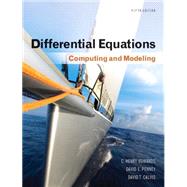For introductory courses in Differential Equations.
This text provides the conceptual development and geometric visualization of a modern differential equations course that is still essential to science and engineering students. It reflects the new emphases that permeate the learning of elementary differential equations, including the wide availability of scientific computing environments like Maple, Mathematica, and MATLAB; its focus has shifted from the traditional manual methods to new computer-based methods that illuminate qualitative phenomena and make accessible a wider range of more realistic applications. Seldom-used topics have been trimmed and new topics added: it starts and ends with discussions of mathematical modeling of real-world phenomena, evident in figures, examples, problems, and applications throughout the text.








